Anarchism in Iran
| Part of a series on |
| Anarchism |
|---|
 |
Anarchism in Iran has its roots in a number of dissident religious philosophies, as well as in the development of anti-authoritarian poetry throughout the rule of
Following a coup d'état and the dissolution of the Soviet Republic, the new Pahlavi dynasty undertook the suppression of the remaining anarchist movement. Socialist movements eventually began to reestablish themselves after the Anglo-Soviet invasion, but the Western-backed coup d'état forced many of these movements underground. Anarchist tendencies started to re-emerge from out of the armed struggle movement but was again suppressed during the Islamic Revolution, only re-organizing itself by the turn of the 21st century.
History

In the time of the
A number of
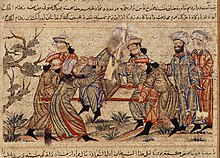
The rise of Shia Islam in Iran saw the development of anarchic tendencies within branches of Isma'ilism, such as the Qarmatians who were noted for their communist practices,[6] and the Nizaris, who established a stronghold in Alamut from which they organised the Order of Assassins, posing a threat to the stability of the Seljuk Empire. The individualist anarchist tendencies of the Assassins were noted by the contemporary Muslim anarchist Peter Lamborn Wilson, writing on their abrogation of the law in Alamut that:[7]
In a sense, anyone can be the Imam; in a sense, everyone already is the Imam [...] the idea of the Imam-of-one's-own-being implies the idea of self-rule, autarky: each human being a potential king, and human relations carried out as a mutuality of “free lords.” [...] To liberate everyday life [...] begins with the individual and spirals outward in love to embrace others.[...] “radical” (post-Qiyamat) Ismailism restores “sovereignty” to the individual, who thus becomes his/her own “authority.” Spirituality is not a master/slave relation—it is not an “Oriental despotism.” Not any more. Not now. Maybe it never was.
By the beginning of the 13th century, an

Shortly after the establishment of the
Constitutional Revolution
During the reign of
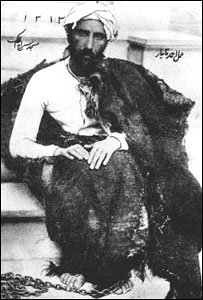
Rising anti-authoritarian sentiments in the country had given way to a sustained period of revolt against the absolutist rule of the Qajars, with the most notable example being the protest movement against the concession of tobacco to the United Kingdom.[14] The assassination of Naser al-Din by Mirza Reza Kermani lay the groundwork for political change in Iran, culminating in 1906 with the outbreak of the Constitutional Revolution, which transformed the Sublime State of Iran into a constitutional monarchy.
The relative liberalism of
As liberals attempted to push more reforms through the Assembly, extra-parliamentary radicals organized a campaign for
Armed constitutionalist uprisings broke out throughout the country, with the Society of Guilds organizing a general strike and a number of provincial governments declaring their autonomy.[27] Revolutionary socialists of the Secret Center, working together with Armenian intellectuals and Azeri social-democrats, began to build an independent "proletarian organization" that received hundreds of armed volunteers from the Caucasus, led by Sattar Khan and Baqir Khan.[28] Civil war split the city of Tabriz along class lines, with Ahmad Kasravi observing that: "the sans~culottes and the propertyless poor reared their heads. The driving force of these men was toward anarchy. First to overthrow the despotic power of the court, then to turn against the rich and the propertied classes."[29] Though the constitutionalists were victorious in Tabriz, they discovered that the city's lower classes had largely sided with the clergy against the revolution.[30]
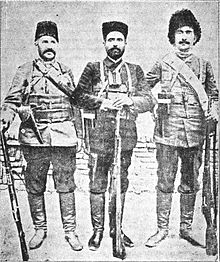
Leading a coalition of Social Democrats, Social Revolutionaries and the
The two most prominent political parties to emerge from the Revolution were the right-wing
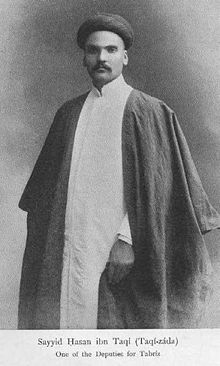
The Democrats' proposed reforms drew a sharp opposition from the Moderates who, after taking power in 1909, called for the defense of society against "the terrorism of the anarchists, the atheism of the Democrats, and the materialism of the Marxists."[39] The policy of secularism particularly divided the two parties, culminating in the assassination of the cleric Seyyed Abdollah Behbahani by the democrat Hassan Taqizadeh, with the government subsequently ordering the disarmament of the general public.[40] When series of tribal revolts broke out amongst the country's ethnic minority populations,[41] the Russian Empire took the opportunity to occupy the cities of Enzeli and Rasht, demanding a number of concessions under threat of Tehran being occupied.[42] This resulted in the dissolution of the 2nd Majlis and a wave of mass protests and riots breaking out against the Anglo-Russian occupation, which were ultimately unsuccessful.[43] With its leaders in exile, the radical movement largely dissolved, with only the Dashnaks and Armenian volunteer police officers providing continuity for the left-wing constitutionalist movement.[44]
During
Social Revolution
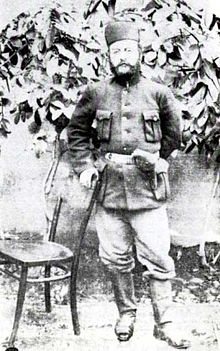
With the outbreak of the
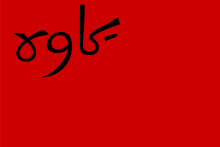
By May 1920, the Persian Socialist Soviet Republic had been established by a united front of Jangalis led by Mirza Kuchik Khan, anarchists led by Ehsanollah Khan Dustdar and communists led by Haydar Khan Amo-oghli.[51] Despite styling itself as a socialist republic, Kuchik's government was made up largely of conservative Islamists, which ordered its people to abide by religious tradition and attracted support from the province's merchant class.[52]
By this point the anarchists and communists had begun to build dual power with the establishment of a "Revolutionary Committee", separate from Kuchik's Commissariat, with its power base in the Gilani Red Army - commanded by Ehsanollah.[53] Tensions between the Jangalis and the communists began to heighten, as communists began to use armed force to collect taxes and introduced many foreign elements into the Gilani Red Army, alienating much of the province's population.[54] Furthermore, the invasion of Gilan by the Russian Red Army exacerbated tensions with the central government in Tehran and led to the intervention of the British Empire,[55] which supported a coup d'état against the government by Reza Khan's Persian Cossack Brigade.[56]
Before long factional rivalries had broken out over a divergence between their vision for the Gilan revolution: Kuchik and the Jangalis were aiming for the spread of a nationalist and constitutionalist revolution, where Ehsanollah and the communists were agitating for a social revolution, reflecting the respective positions of the Moderates and Democrats, which these factions had originally emerged from.[57] On July 31, 1920, the left-wing factions staged a coup, with Ehsanollah commanding the Red Army to overthrow the Commissariat government, forcing Kuchik to flee the capital of Rasht.[58] The new "Red Cabinet", headed by Ehsanollah Khan and composed of leftist Jangalis, members of the Communist Party, anarchists and leftist democrats, implemented a system of "war communism" and instituted class warfare against capitalism and feudalism.[59] During its time in power, Ehsanollah's government greatly reduced unemployment, implemented a wide-reaching education program and attempted to establish a national bank along mutualist lines.[60] But the radicalism of the new government, combined with the lack of native Gilanis in official positions and its anti-religious campaign, heightened tensions between the government and the local population.[61] Local clerics issued a fatwa against the government and land redistribution efforts were even rejected by the peasantry under religious grounds.[62] The Gilani peasantry and middle classes, who largely supported a national revolution rather than a social revolution, became alienated from the new soviet government, leading to Kuchik Khan's armed resistance to the communist government receiving a considerable amount of support from native Gilanis.[63]
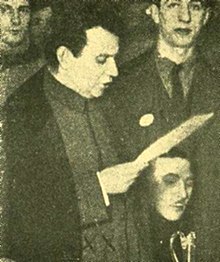
Members of the red government, including Ehsanollah Khan, attended the
With Haydar now moderating communist policy, Ehsanollah's government abandoned war communism and implemented a "New Economic Policy", which deemphasized class warfare and world revolution, relaxed government intervention in the economy and everyday life, and put an end to its anti-religious campaign. Haydar also mediated a truce with Kuchik Khan, who rejoined the soviet government in May 1921 as part of a reinvigorated united front. Sultan-Zade's left communist faction was excluded from the government and Ehsanollah was demoted to a minor role.[68] By August 1921, Haydar's faction had entirely excluded anarchists and left communists from the Soviet government, dismissing Eshanollah from his governmental post and abandoning the remains of his radical program, culminating in Haydar re-proclaiming the Soviet Republic under his rule.[69] Following his expulsion from the government, Ehsanollah led a force of 3,000 Gilani Red Army troops in a march on Tehran, but was routed by Fazlollah Zahedi, revealing a weakness within the Gilan Republic's revolutionary strength.[70]
Internal tensions within the soviet government over land reform culminated with right-wing Jangalis staging a coup, assassinating Haydar Khan and destroying the headquarters of the Communist Party, and entering into negotiations with the central government.[70] Meanwhile, Reza Khan's government had signed a "Treaty of Friendship" with Soviet Russia, negotiating the withdrawal of the Russian Red Army from Gilan in October 1921 and thereafter reasserting the central government's control over the province.[71] Following the destruction of the Gilan Republic, an armed conflict broke out between right-wing forces led by Mirza Kuchik Khan and left-wing forces led by Ehsanollah Khan, ending in a leftist victory as Kuchik's forces fled into the Talesh mountains. Kuchik soon succumbed to frostbite and died in hiding, where Ehsanollah was eventually forced into exile in Baku.[72] By 1925, Reza Khan had been proclaimed Shah by the Majlis, deposing the Qajars and establishing the rule of the Pahlavi dynasty over Iran.[73]
In February 1927, Ehsanollah Khan travelled to Moscow where he met with other Iranian revolutionaries and began planning to create an underground revolutionary network, in order to agitate amongst the Iranian populace. He envisioned this as acting independently from the now-underground Communist Party of Persia and requested support from the Comintern Executive Committee, conditional on it not interfering in his activities. From Baku he coordinated the establishment of this network, led by his brother in Tehran, which began its clandestine activities.[74] However, the Comintern reneged on its promised support following the ratification of a trade deal between Iran and the Soviet Union in October 1927.[75] Following a subsequent congress held by the reactivated Communist Party, the Comintern resolved to cut ties with Ehsanollah Khan and dissolved his nascent revolutionary network. In 1928, after Ehsanollah Khan distributed a number of caricatures depicting Reza Shah as a puppet of the British Empire, communications between the Iranian and Azerbaijani governments resulted in the NKVD ordering him and his network to forever cease and desist their political activities.[76] Ehsanollah Khan was later executed as an "enemy of the people" during the Great Purge. By 1930, in reaction to the revived activities of the Communist Party, Reza Shah ordered the passage of a national security law that outlawed the propagation of "collectivist ideology", which included socialism, communism and anarchism.[77]
Resurgence of socialism
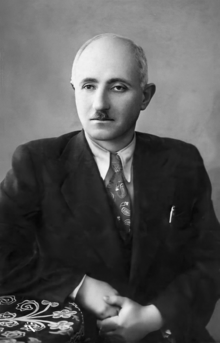
Following the

Tudeh subsequently entered into an internal feud over their policies of unconditional support for the Soviet Union and opposition to the national liberation struggles in
The Iran Party went on to found the National Front coalition, together with Mohammad Mosaddegh, which was elected to the Majlis and led the effort to nationalize the Anglo-Persian Oil Company in 1951, eventually forming a minority government. The government was re-elected with popular support, but was later overthrown in a monarchist coup backed by the United States and United Kingdom. The Shah consolidated power and began to rule as an autocrat, suppressing the country's left-wing opposition with a newly established secret police known as the SAVAK. Eventually, the Shah declared that opposition to his regime was "limited to a handful of nihilists, anarchists and communists",[85] as many left-wing political leaders had already fled the country.[86]
In 1955, the socialist Rezazadeh Shafaq commented that "I thoroughly agree with Western observers who describe Iran as a nation of anarchistic individuals. In our country, everyone considers himself a leader, sets his own goals, goes his own way, and without compunction tramples over others."[87]
Armed struggle
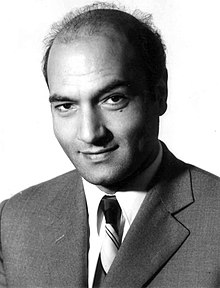
Inspired by his teacher Louis Massignon, Ali Shariati constructed a revolutionary form of Islamic socialism that characterised Muhammad and Ali as fighters of a class war on the side of the proletariat,[88] in a synthesis of Marxism and existentialism together with a militant form of Shia Islam.[89] Following his imprisonment in 1964, Shariati developed a new-found appreciation for individual freedom, his conception of which stood in opposition to dictatorship, imperialism and exploitation. He believed in a form of "goal-oriented Islamic freedom" that could secure falah and argued that revolutionary education could liberate society from "ignorance and injustice". In his narrative poem Freedom, blessed Freedom, Ali Shariati wrote:[90]
"O freedom, I despise governments, I despise bondage, I despise chains, I despise prisons, I despise governments, I despise dictation, I despise whatever and whomever enchains you."
According to
Following the Sino-Soviet split, the Tudeh Party had taken a pro-Soviet line and renounced violent revolutionary action, labelling it as essentially anarchist and contrary to Marxism-Leninism, claiming that the Iranian movement for armed struggle lacked a revolutionary class consciousness.[93] In response, a number of Iranian communist students in Europe split from the party in order to pursue a policy of armed struggle against the Shah, founding the Revolutionary Organization of the Tudeh Party (ROTP) along Maoist lines.[94] When the ROTP published a pamphlet claiming that “the revolution in Iran will only succeed through the violent approach and armed struggle”, Tudeh responded by accusing them of taking "a completely sectarian, left-wing and adventurist" stance, denouncing the ROTP's "petty-bourgeois revolutionariness" which Tudeh claimed "resembled anarchism".[95] Many ROTP members that returned to Iran to undertake an armed struggle against the Shahist government were captured, tortured and killed.[96] Others, including the leading ROTP figure Parviz Nikkhah, converted to monarchism while imprisoned, becoming outspoken advocates of the White Revolution and opponents of revolutionary armed struggle.[97]
In the wake of the suppression of the June Uprising, former members of the Freedom Movement took part in the foundation of the People's Mojahedin Organization of Iran (MEK).[98] The MEK's ideology drew inspiration from a number of different areas, including Shiite beliefs, Marxist theory and insurrectionary anarchist practice. Through the Spanish anarchist Abraham Guillén and the Brazilian communist Carlos Marighella, they adopted the Bakuninist revolutionary strategy of propaganda of the deed, which they synthesised with the Islamic concept of Istishhad.[99]
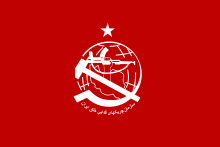
In 1971, a Marxist group known as the
Popular unrest against the Shah's government culminated in 1978, with the outbreak of the
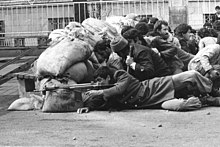
By January 1979, the Shah had fled to country and guerrilla organizations such as the MEK and OIPFG had launched an insurrection against the state, taking over key centres of military infrastructure.[104] The shuras quickly became the basis of the new Iranian society, setting up agricultural collectives and self-managed enterprises, establishing neighborhood assemblies and even arming the population. Over a million people participated in the May Day demonstration of that year in Tehran and the headquarters of the state-controlled trade union federation was occupied by workers, who established the Workers' House in its place and called for every factory in Iran to form their own shuras. The South African anarchist Michael Schmidt described this period as "a true workers' revolution with secular revolutionaries and Muslim workers overthrowing the capitalist state side by side."[105]
But before long,
Contemporary resurgence
Following the revolution, the OIPFG had split up into a number of different factions: when the
The process of anarchist ideas once again beginning to take hold within Iran and the
References
- ^ Crone 1991, p. 24; Marshall 1993, p. 86.
- ^ Crone 1991, p. 24.
- ^ Marshall 1993, p. 86.
- ^ Crone 2000, pp. 12–15.
- ^ Schmidtke 2017, p. 9.
- ^ Fiscella 2009, p. 282.
- ^ Fiscella 2009, p. 295.
- ^ Karamustafa 1994, pp. 37–38.
- ^ Crone 2000, p. 20.
- ^ Amanat 2012, p. 176.
- ^ a b Matin-Asgari 2018, p. 31.
- ^ a b Amanat 2012, p. 177.
- ^ Ghods 1989, p. 20.
- ^ a b c d Melis 2009, p. 1.
- ^ Ghods 1989, pp. 79, 90.
- ^ Abrahamian 1982, pp. 76–80.
- ^ Abrahamian 1982, pp. 80–85.
- ^ Abrahamian 1982, pp. 86–87.
- ^ Abrahamian 1982, pp. 88–92.
- ^ Abrahamian 1982, p. 92.
- ^ Abrahamian 1982, pp. 92–93.
- ^ Abrahamian 1982, p. 93.
- ^ Abrahamian 1982, pp. 93–94.
- ^ Abrahamian 1982, p. 94.
- ^ Abrahamian 1982, p. 95.
- ^ Abrahamian 1982, pp. 95–97.
- ^ Abrahamian 1982, p. 97.
- ^ Abrahamian 1982, pp. 97–98.
- ^ Abrahamian 1982, p. 98.
- ^ Abrahamian 1982, pp. 98–99.
- ^ Abrahamian 1982, p. 99.
- ^ Abrahamian 1982, pp. 99–100.
- ^ Abrahamian 1982, pp. 100–101.
- ^ Ghods 1989, p. 43.
- ^ Abrahamian 1982, p. 103.
- ^ Abrahamian 1982, pp. 103–104.
- ^ Abrahamian 1982, p. 104.
- ^ Abrahamian 1982, p. 105.
- ^ Abrahamian 1982, p. 106.
- ^ Abrahamian 1982, pp. 106–107.
- ^ Abrahamian 1982, pp. 107–108.
- ^ Abrahamian 1982, pp. 108–109.
- ^ Abrahamian 1982, pp. 109–110.
- ^ Abrahamian 1982, pp. 110–111.
- ^ a b Abrahamian 1982, p. 111.
- ^ Ghods 1989, p. 88.
- ^ Ghods 1989, p. 51.
- ^ Abrahamian 1982, pp. 111–112.
- ^ Tulsiram 1981, p. 47.
- ^ Abrahamian 1982, p. 112.
- ^ Tulsiram 1981, p. 44.
- ^ Ghods 1989, p. 65.
- ^ Ghods 1989, pp. 66–67.
- ^ Ghods 1989, pp. 67–68.
- ^ Ghods 1989, pp. 68–70.
- ^ Ghods 1989, pp. 70–71.
- ^ Ghods 1989, pp. 78–79.
- ^ Ghods 1989, p. 79.
- ^ Ghods 1989, p. 81.
- ^ Ghods 1989, p. 92.
- ^ Ghods 1989, pp. 80–81.
- ^ Ghods 1989, pp. 81–82.
- ^ Ghods 1989, pp. 82–83.
- ^ Ghods 1989, pp. 83–84.
- ^ Ghods 1989, p. 84.
- ^ Ghods 1989, p. 85.
- ^ Ghods 1989, pp. 85–86.
- ^ a b Ghods 1989, p. 86.
- ^ Ghods 1989, p. 87.
- ^ a b Ghods 1989, p. 89.
- ^ Abrahamian 1982, p. 119.
- ^ Volodarsky 2014, pp. 64–65.
- ^ Ghods 1989, pp. 96–97.
- ^ Atabaki 2013, p. 314.
- ^ Atabaki 2013, p. 315.
- ^ Atabaki 2013, p. 316.
- ^ Abrahamian 1982, p. 154.
- ^ Abrahamian 1982, p. 221.
- ^ Abrahamian 1982, pp. 235–238.
- ^ Abrahamian 1982, pp. 309–311.
- ^ Dabashi 2017, p. 217.
- ^ Dabashi 2017, p. 219.
- ^ Dabashi 2017, p. 220.
- ^ Shahibzadeh 2015, p. 217.
- ^ Abrahamian 1982, p. 500.
- ^ a b Rahnema 2020, p. 147.
- ^ Abrahamian 1982, p. 169.
- ^ Knight 2012, p. 60.
- ^ Veneuse 2009, p. 254.
- ^ Rahnema 1994, p. 241.
- ^ Byrd & Miri 2017, p. 5.
- ^ Fiscella 2009, p. 294.
- ^ Rahnema 2020, pp. 174–175.
- ^ Rahnema 2020, pp. 135–136.
- ^ Rahnema 2020, p. 140.
- ^ Rahnema 2020, p. 158.
- ^ Rahnema 2020, pp. 158–160.
- ^ Abrahamian 1989, pp. 85–87.
- ^ Abrahamian 1989, p. 100.
- ^ Abrahamian 1982, p. 487.
- ^ Rahnema 2020, p. 150.
- ^ Abrahamian 1982, p. 489.
- ^ a b c Schmidt 2013, p. 91.
- ^ Schmidt 2002, p. 9.
- ^ Schmidt 2002, pp. 9–10.
- ^ Schmidt 2002, p. 10.
- ^ Schmidt 2013, p. 92.
- ^ Zabir 2012, pp. 108–110.
- ^ Vahabzadeh 2016.
- ^ Piedar 2005.
- ^ Golkar, Nima (4 May 2020). "From a Shia Muslim to an Anarcho-Syndicalist". Anarchism Era. Federation of Anarchism Era.
- ^ a b c AUIA; TFSR (12 January 2020). "Perspectives from Iranian Anarchists". The Final Straw Radio. Retrieved 28 October 2021.
- ^ Schmidt 2013, p. 106.
- ^ Asranarshism (20 May 2018). "Announcing the formation of the Anarchist Union of Afghanistan & Iran". Anarchism Era. Federation of Anarchism Era. Retrieved 28 October 2021.
- ^ Asranarshism (25 July 2019). "Interview with Anarchist Union of Iran and Afghanistan". Abolition Media Worldwide. Archived from the original on 8 January 2020.
- ^ Ó Máille, Peter (28 November 2019). "The Revolt in Iran". Freedom. Freedom Press. Retrieved 28 October 2021.
Bibliography
- Abrahamian, Ervand (1982). Iran: Between Two Revolutions. OCLC 251638189.
- Abrahamian, Ervand (1989). The Iranian Mojahedin. OCLC 925091392.
- Amanat, Abbas (2012). "The Historical Roots of the Persecution of Babis and Baha'is in Iran". In Parviz Brookshaw, Dominic; Fazel, Seena B. (eds.). The Baha'is of Iran: Socio-Historical Studies. OCLC 1027496514.
- Atabaki, Touraj (2013). "The Comintern, the Soviet Union and labour militancy in interwar Iran". In Cronin, Stephanie (ed.). Iranian-Russian Encounters: Empires and Revolutions Since 1800. OCLC 1257352452.
- Byrd, Dustin J.; OCLC 1053531897.
- Crone, Patricia (1991). "Kavad's Heresy and Mazdak's Revolt" (PDF). Iran: Journal of the British Institute of Persian Studies. 29: 21–40. OCLC 5543699603. Archived from the original(PDF) on 2019-11-02. Retrieved 2021-12-14.
- OCLC 4639911110.
- Dabashi, Hamid (2017). Theology of Discontent: The Ideological Foundation of the Islamic Revolution in Iran. OCLC 997425699.
- Deutschmann, Moritz (2015). Iran and Russian Imperialism: The Ideal Anarchists, 1800-1914. OCLC 945764907.
- Fiscella, Anthony T. (2009). "12. Imagining an Islamic Anarchism: A New Field of Study is Ploughed". In Christoyannopoulos, Alexandre J. M. E. (ed.). Religious Anarchism: New Perspectives. OCLC 667050168.
- Ghods, M. Reza (1989). Iran in the Twentieth Century: A Political History. OCLC 473000977.
- Karamustafa, Ahmet T. (1994). "III. Renunciation, Deviant Individualism, and Sufism". God's Unruly Friends: Dervish Groups in the Islamic Middle Period 1200-1550. OCLC 43476590.
- Knight, Michael Muhammad (2012). William S. Burroughs vs. The Qur'an. OCLC 792687937.
- OCLC 1042028128.
- Matin-Asgari, Afshin (2018). Both Eastern and Western: An Intellectual History of Iranian Modernity. OCLC 1051454142.
- Melis, Rachel (2009). "Anarchism, Iran". In Ness, Immanuel (ed.). The International Encyclopedia of Revolution and Protest. OCLC 8682032907.
- Piedar, Payman (2005). "Interview with an Iranian Anarchist". The Northeastern Anarchist (10). OCLC 47639698.
- Rahnema, Ali (1994). "9. Ali Shariati: Teacher, Preacher, Rebel". In Rahnema, Ali (ed.). Pioneers of Islamic Revival. OCLC 1158887402.
- Rahnema, Ali (2020). Call to Arms: Iran's Marxist Revolutionaries. OCLC 1230150768.
- Schmidt, Michael (March 2002). "Religious Fundamentalist Regimes: A Lesson from the Iranian Revolution 1978-1979". Zabalaza (2). OCLC 67613414.
- Schmidt, Michael (2013) [2012]. Cartography of Revolutionary Anarchism. OCLC 881111188.
- Schmidtke, Sabine (2017). "The People of Monotheism and Justice: Muʿtazilism in Islam and Judaism". The Institute Letter. OCLC 1056628029.
- Shahibzadeh, Yadullah (2015). The Iranian Political Language: From the Late Nineteenth Century to the Present. Springer. OCLC 991746393.
- Tulsiram (1981). The History of Communist Movement in Iran. OCLC 9486137.
- Vahabzadeh, Peyman (28 March 2016) [7 December 2015]. "FADĀʾIĀN-E ḴALQ". In OCLC 8700134581. Retrieved 1 August 2016.
- Veneuse, Mohamaed Jean (2009). "11. To Be Condemned to a Clinic: The Birth of the Anarca-Islamic Clinic". In Christoyannopoulos, Alexandre J. M. E. (ed.). Religious Anarchism: New Perspectives. OCLC 667050168.
- Volodarsky, Mikhail (2014). The Soviet Union and Its Southern Neighbours: Iran and Afghanistan 1917-1933. OCLC 879023360.
- Zabir, Sepehr (2012). Iran Since the Revolution (RLE Iran D). OCLC 7385647003.
External links
- Iran topic - The Anarchist Library
- Iran topic - Libcom.org
